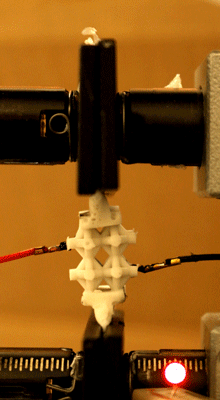A world with bendable cellphones may not be that far off
New 3-D material developed by USC Viterbi engineer could revolutionize flexible electronics
A world with flexible electronics — screens you can roll up or cellphones that can bend — may not be so far away. Researchers and electronics

companies have been working on developments in this
field for years, using 3-D printing to provide low-cost manufacturing of flexible devices that are rugged, lightweight and portable.
The advancement of thin-film has led to a handful of pliant items, such as bendable transistors and stretchable circuits that make building electronics easier. However, without an entire array of flexible components, a completely flexible device cannot be produced.
Using his novel 3-D printing technique, Qiming Wang, an assistant professor at USC Viterbi School of Engineering, has developed a material that could create some of these components. Scientific Reports published an article detailing his findings in late September.
“Plastic 3-D printing is traditional — lots of 3-D printers can print these kinds of structures. However, this kind of soft material 3-D printing in this kind of complex geometry, I would say this is a first,” said Wang, a member of the Sonny Astani Department of Civil and Environmental Engineering.
Using a typical rubber material, called an elastomer, Wang manufactured a 3-D lattice structure with incredible stretchability and shock-absorption qualities. Wang believes it could be used for a number of applications, including robotics, joint rehabilitation, cushioning and, yes, flexible electronics.
One thin layer at a time
Traditional 3-D printing is typically associated with rigid, plastic structures made of PLA (polylactic acid) or ABS (acrylonitrile butadiene styrene), created one thin layer at a time. While a small selection of rubber-like materials has been developed for 3-D printers, they do not provide the substantial flexibility or motion needed to build flexible electronics. Additionally, printing flexible materials consisting of a highly intricate 3-D lattice is extremely challenging.
Wang has addressed this by using a new fabrication method. He begins by printing a 3-D scaffold of plastic material but, instead of solid beams, he creates hollow channels that are then filled with liquid elastomer. Over a period of several hours, sitting at room temperature, the liquid solidifies. Finally, the plastic, which is water dissolvable, is removed, leaving a freestanding, 3-D printed rubber.
When comparing the novel design to similar materials, such as other 3-D printed materials, Wang found his could stretch nearly twice as much as that created by the competition. In fields like robotics that are turning to 3-D printing for low-cost part manufacturing, designs are limited by what materials are available. In their case, Wang’s new development may literally be the missing link.
“In robotics, you have lots of joints, so you need a lot of flexibility to rotate or bend,” Wang said. “We imagine our soft material 3-D printing can do that here. We can bridge rigid structures and do large angle rotation, large angle bending and stretching.”
His material also has superb shock absorption qualities, outperforming conventional elastomer foams used in cushioning during impact-loading tests. Additionally, by offering a customizable rigidity, his material could be used in joint rehabilitation, replacing existing brace designs.
